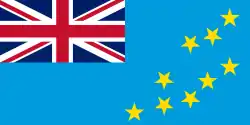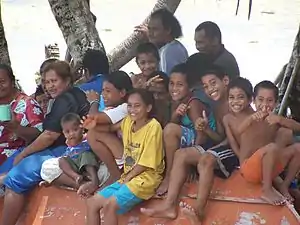Demographics of Tuvalu
This article is about the demographic features of the population of Tuvalu, including the age structure, ethnicity, education level, life expectancy, religious affiliations and other aspects of the population.
 | |
| Languages | |
|---|---|
| Tuvaluan and English | |
| Religion | |
| Christianity, Polytheism, Polynesian narrative | |
| Related ethnic groups | |
| Other Polynesians |

Summary of the demographics of Tuvalu

The population of Tuvalu is predominately of Polynesian ethnicity with approximately 5.6% of the population being Micronesian.[1] Tuvaluans are ethnically related to the people of Samoa and Tonga. There is evidence for a dual genetic origin of Pacific Islanders in Asia and Melanesia, which results from an analysis of Y chromosome (NRY) and mitochondrial DNA (mtDNA) markers. There is also evidence of Fiji playing a pivotal role in west-to-east expansion within Polynesia.[2]
The vast majority of Tuvaluans belong to the Church of Tuvalu, a Protestant denomination. Their ancestors were converted by Christian missionaries in the 19th century.
Infant mortality in Tuvalu was 25 deaths per 1,000 live births in 2012, with an under-five mortality rate of 30 deaths per 1,000 live births. There has been a consistent decline in the under-five mortality rate since 1990.[3]
School attendance at school is 10 years for males and 11 years for females (2001).[4] Adult literacy rate is 99.0% (2002).[5]
Life expectancy for women in Tuvalu is 68.41 years and 64.01 years for men (2015 est.).[4]
The population of Tuvalu is recorded by the Central Statistics Department (CSD) of Tuvalu in the census information:[7]
| 1979 Census | 1985 Census | 1991 Census | 2002 Census | 2012 Census | 2017 Census |
|---|---|---|---|---|---|
| 7,349[8] | 8,229[8] | 9,043[8] | 9,359[8] | 10,640[8] | 10,507[8] |
The net migration rate is estimated at -6.81 migrant(s)/1,000 population (2015 est.).[4] The threat of global warming in Tuvalu is not a dominant motivation for migration as Tuvaluans appear to prefer to continue living on the islands for reasons of lifestyle, culture and identity.[9]
The Census Monograph on Migration, Urbanization and Youth provides an analysis of the 2012 census and reported:[10]
- A total of 1,200 people were listed as being out of country on census night with more males (57%) than females (43%) absent. The high proportion in range of ages 15 to 29 years (37% of the total) is described as indicating the significance of overseas tertiary education and training.[10]
- The 2013 Census of New Zealand reported 3,537 Tuvaluans, an increase of 80% from the 1,965 reported in the 2001 census. In the 2013 census, only about 40% (1,419) had been born in Tuvalu. The high proportion of Tuvaluans who are New Zealand born illustrates the significance of New Zealand as a long term destination for Tuvaluan migrants.[10][11]
- The Tuvaluan community in Australia is recorded in the 2011 Australian Census as 228 people who put Tuvaluan as their first response to a question on ‘ancestry’; of these 120 were born in Tuvalu.[10]
- The islands of Nanumea, Nanumaga, Nukufetau and Niutao had relatively high net migration losses, with most being internal migrants to Funafuti. Vaitupu had the largest net migration gain, although this is attributed to the location of Motufoua Secondary School on Vaitupu and the movement of students from the other islands.[10]
Demographic statistics
The following demographic statistics are from the CIA World Factbook,[12] unless otherwise indicated.

Population
.png.webp)
- 11,052 (estimate as of July 2017)
Age structure
- 0–14 years: 29.4% (male 1,639/female 1,557)
- 15–24 years: 20.27% (male 1,157/female 1,046)
- 25–54 years: 36.35% (male 1,946/female 2,005)
- 55–64 years: 8.41% (male 373/female 541)
- 65 years and over: 5.57% (male 247/female 358) (2015 est.)
Median age
- Total: 25.2 years
- Male: 24.1 years
- Female: 26.6 years (2015 est.)
Population growth rate
- 0.82%
Birth rate
- 23.74 births/1,000 population
Death rate
- 8.74 deaths/1,000 population (2015 est.)
Net migration rate
- -6.81 migrant(s)/1,000 population (2015 est.)
Sex ratio
- At birth: 1.05 male(s)/female
- 0–14 years: 1.05 male(s)/female
- 15–24 years: 1.11 male(s)/female
- 25–54 years: 0.97 male(s)/female
- 55–64 years: 0.69 male(s)/female
- 65 years and over: 0.69 male(s)/female
- Total population: 0.97 male(s)/female (2015 est.)
Infant mortality rate
- Total: 30.8 deaths/1,000 live births
- Male: 33.46 deaths/1,000 live births
- Female: 28.01 deaths/1,000 live births
Life expectancy at birth
- Total population: 66.16 years
- Male: 64.01 years
- Female: 68.41 years
Total fertility rate
- 3 children born/woman
Demonym
- Tuvaluan(s) (noun)
- Tuvaluan (adjective)
Ethnic groups
- Polynesian 96%
- Micronesian 4%
Religions
- Church of Tuvalu 97%
- Seventh-day Adventist Church 1.4%
- Baháʼí 1%
- all other faiths or denominations ≈ 1%
Languages
- Tuvaluan (official)
- English (official)
- Samoan
- Ikiribati language (on the island of Nui)
See also
References
- "Population of communities in Tuvalu". world-statistics.org. 11 April 2012. Retrieved 20 March 2016.
- "Melanesian and Asian Origins of Polynesians: mtDNA and Y Chromosome Gradients Across the Pacific". Anthrocivitas.net. October 2009. Retrieved 23 January 2014.
- "Global AIDS Progress Report of Tuvalu" (PDF). Ministry of Health Tuvalu. 2016. Retrieved 29 November 2017.
- "Australia-Oceania :: TUVALU". CIA The World Factbook.
- "Tuvalu: 2010 Article IV Consultation-Staff Report; Public Information Notice on the Executive Board Discussion; and Statement by the Executive Director for Tuvalu". International Monetary Fund Country Report No. 11/46. 8 February 2011. Retrieved 4 September 2011.
- "Tuvalu: 2014 Article IV Consultation-Staff Report; Public Information Notice on the Executive Board Discussion; and Statement by the Executive Director for Tuvalu" (PDF). International Monetary Fund Country Report No. 14/253. 5 August 2014. p. 18. Retrieved 21 March 2016.
- "Census of Population and Housing and sample Surveys". Central Statistics Division – Government of Tuvalu. 2006. Archived from the original on 10 August 2011. Retrieved 17 Oct 2011.
- "Population of communities in Tuvalu". Thomas Brinkhoff. 2020. Retrieved 15 January 2021.
- Colette Mortreux & Jon Barnett (2009). "Climate change, migration and adaptation in Funafuti, Tuvalu" (PDF). Global Environmental Change. 19: 105–112. doi:10.1016/j.gloenvcha.2008.09.006. Archived from the original (PDF) on 2016-01-31.
- "Tuvalu Population and Housing Census 2012: Migration, Urbanisation and Youth Monograph". Central Statistics Department (CSD) of Tuvalu/University of Auckland, New Zealand/United Nations Population Fund (UNFPA). 2015. Archived from the original on 24 April 2016. Retrieved 20 March 2016.
- Shen, S., & Binns, T. (2012). "Pathways, motivations and challenges: Contemporary Tuvaluan migration to New Zealand". GeoJournal. 77 (1): 63–82. doi:10.1007/s10708-010-9386-2.CS1 maint: multiple names: authors list (link)
- "Australia-Oceania :: TUVALU". CIA The World Factbook.